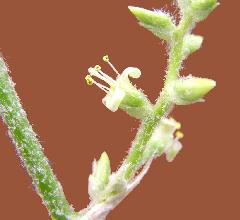
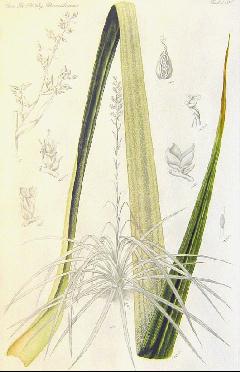
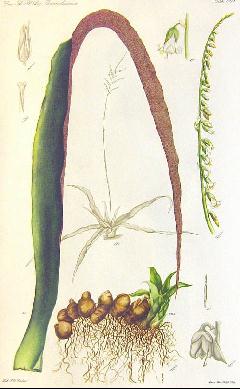
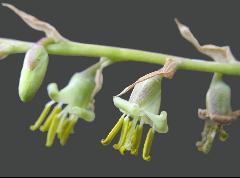
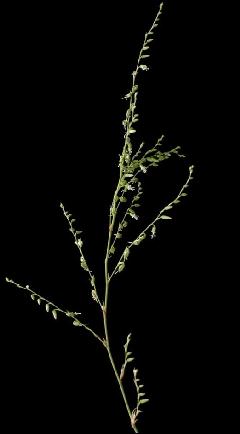
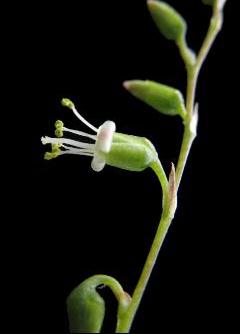
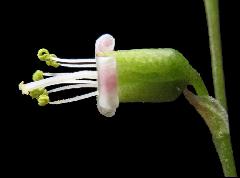
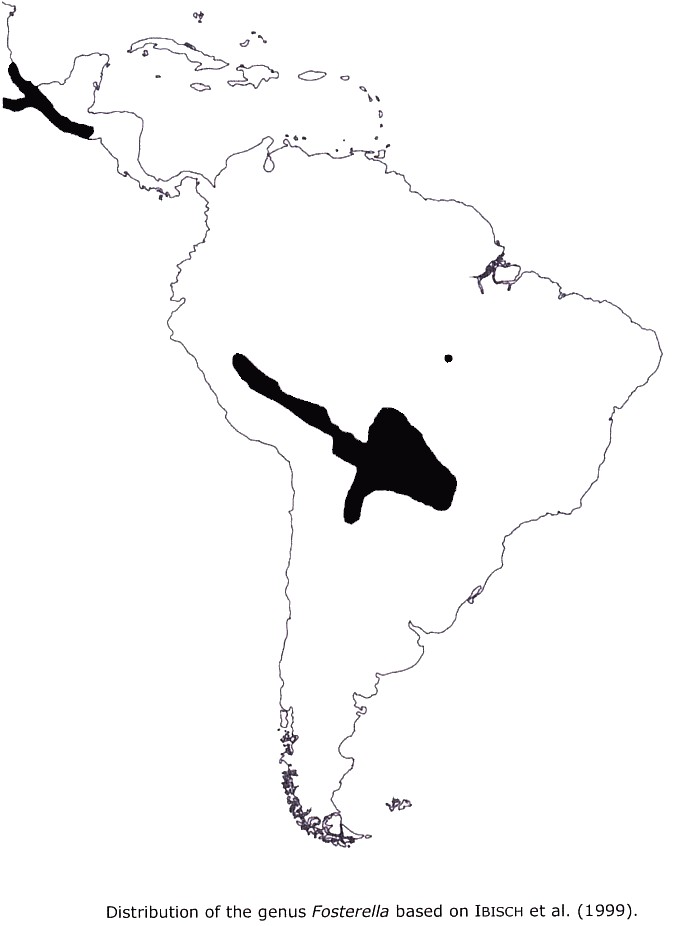
The genus was dedicated to Mulford B. Foster (1888-1978), co-founder and first president of the Bromeliad Society International, and after whom many species names and one other genus have been coined.
First a few notes about the genus based on the work done by Jule Peters in Germany who did her doctorate on the genus in 2009.
The genus Fosterella was established by L.B. Smith in 1960. However, almost half of today's known species had been described in other genera by the 1940s. This shows how difficult it was to find the place that Fosterella took in the general scheme of the sub-family Pitcairnioideae. We are now up to 31!
The first species discovered was the central American Fosterella micrantha, described as Pitcairnia micrantha by Lindley in 1843 but said to have come from Rio de Janeiro!
The following makes interesting reading:
“This singular little species was found among some Orchidaceous plants imported from Rio, in December, 1841, by Lieut. Christopher Smith, of H. M. Packet “Star,” and presented to Sir Charles Lemon, Bart. MP. It flowered at Carclew in March, 1843, and proves to be very distinct from any other of the genus to which it belongs, as well as the smallest that has yet come under my notice. It requires the constant heat of a damp stove; and thrives very well either in loose vegetable matter, or on the decayed branch of a tree.
Leaves numerous, flat, undulated at the margin, flaccid, spreading and recurved, linear-lanceolate acute, from nine inches to a foot long, and about an inch wide; of a deep green above, and a pale glaucous green beneath, without any spines at the edges. Scape erect, nine inches long, issuing from the centre of the plant, of a brownish green, remarkably slender, round and downy, with several linear bracts along the stem, which is half its length, covered with flowers. Flowers white, not exceeding a quarter of an inch across, drooping and opening one or two at a time in succession, from the base upward. Pedicel round, very short, almost concealed by a brown coloured acuminate bract to each. Sepals three, of a pale green, ovate acuminate, alternate with the petals, and about half their length. Petals three, recurved, lanceolate acute. Filaments half as long as the petals, very slender, bearing long yellow anthers, which roll up and; appear as if they were round when the flower has been some time expanded. Ovarium about the length of the sepals, deep green, roundish oblong, crowned by the style, which is round and slender, and a little shorter than the petals." -- Wm. B. Booth
If only we knew where the Orchids had been found we would have a clue as to the actual habitat. What I find intriguing is that this species does not seem to be represented in Australia. From my reading, the main difference between this species and F. penduliflora is that F. micrantha has whitish wool on the axes of the inflorescence. So next time your F. penduliflora flowers check to see that there is no wool. If there is, then please let me know!
The latest described species grow in the Central Andes or in the humid lowlands of central South America. Bolivia, in particular, is a country where new, even surprisingly spectacular species (like the red-flowered Fosterella spectabilis H. Luther 1997) can still be discovered
The collections of Fosterella specimens are still very poor, so remarks on the ecology and range of the species are necessarily of a preliminary nature. However, without doubt the distribution patterns based on the known specimens permit an assessment of the biogeography and diversity of this rather species-poor bromeliad genus. Smith & Downs (1974) were the first to illustrate the range of Fosterella. Taking into consideration new records for both known and new species, I have provided a distribution map, which also tries to give an assessment of the diversity of the genus. Note that the one dot in the Brazilian Amazon basin represents F. batistana
Fosterella is a tropical genus which only enters subtropical forests in Argentina. It is marked by a disjunct distribution. An isolated partial distribution in Central America is formed by F. micrantha. All the other species are known from central South America: in the Andes from Peru (Huanucu) in the north to Argentina (Salta) in the south, and in the lowlands from Bolivia (Santa Cruz) and Brazil (Mato Grosso) to Paraguay. A clear diversity center is located in the dry to semihumid inter-Andean and foothill region of the La Paz Yungas where about 50% of the species are concentrated. A zone of high Fosterella diversity is found in an adjacent area in Southern Peru. With regard to the other genera of Bromeliaceae, Fosterella is probably unique by having its diversity centre in this region
In all other known ranges, it is not likely to find more than one or two species within a small region. Up to now the distribution in the Bolivian Andes seems to be discontinuous. It is possible that new records may fill the distributional gaps. Most of the Fosterella species are not found in very humid forests such as those that are present in the mentioned gap of the Cochabamba Yungas. Most of them occur in dry to semihumid forests like those typical for inter-Andean regions and the edge of the Chaco. In the South American lowlands the Fosterella species apparently depend on mountain chains and rocky slopes. Here, none of the species is found on forest floors. In the Andes, most of the species are found below 1,500 metres in elevation; F. albicans and F. schidosperma are even known from sites at altitudes around 2,000 metres.
Currently more than 80% of the Fosterella species have to be considered as local endemics. A high tendency to endemism is observed within most genera of the subfamily Pitcairnioideae. The small seeds, which are not dust like, are not suited for long-distance dispersal. So, especially those taxa which live in more or less isolated dry or semihumid forests may evolve species characterized by small ranges. The diversity centre of the genus Fosterella in Bolivia is, at the same time, the centre of local endemics which up to now only have been found at or near the type locality.
Probably none of the Fosterella species is currently endangered. Many of the local endemics live in rocky areas or the habitats that are not suffering such transformations that might prove detrimental to their existence. Furthermore, the species are not very attractive for many horticulturists, so over collecting would not seem to be a potential threat.
This view of the academic is a general one, often made as an answer to decline of species in the wild. I would suggest that Fosterella species do not need to be re-collected in the wild for horticultural consumption because in this genus all species seem to be self fertile and set thousands of seed. That Fosterella spectabilis has become wide spread in Australia in a short 10 years is testimony to this fact!
Horticulturally speaking Fosterella seem to thrive best in conditions reserved for Cryptanthus, certainly in Adelaide it does not take long for the leaf tips to dry off. This drying of the leaves continues after flowering until you are left with a nub. From this nub a stolon emerges ready to produce an offset for next season’s flowering. The dead leaves can be easily removed with scissors. Some plants just offset in one direction with the plant just wanting to grow outside the pot’s perimeter! I have found that if the last two nubs are removed from the main plant they will readily grow in the warmer weather. Those left in the pot will also sprout. So it is not just by seed that you can propagate this genus! The potting mix can be the same as for Cryptanthus despite the rocky conditions they endure in the wild. The only thing you have to remember is that when they flower they have a tall peduncle and a long inflorescence. To my mind this genus has more class than Cryptanthus because you never see a hybrid whereas in a Cryptanthus collection you rarely see a species. Species have a pedigree where someone has gone to the trouble of describing its attributes which is somewhat lacking with a hybrid!
Ever since I started growing plants from this genus some 30 years ago I found them difficult to identify when following Lyman Smith. Recent years in my contact with Pierre Ibisch and the later Jule Peters I have learnt some of the nuances of identity which is much more in the flower than leaf.
For some reason Sydney seems the epicentre of Fosterella in Australia and it is the plants that have an old history that have caused me the most headaches. I have never been able to find out if they came to Australia by seed or plant. Perhaps if I go through the names I have encountered so far we can address possible identity problems.
F. albicans. This seems to have been around for some years without a name. Peter Franklin from Raymond Terrace NSW in about 2000 identified it as this species. This was followed up by Ross Little of PineGrove who wondered why there was so much discrepancy in size but we were assured by Pierre Ibisch that this could be the case.
F. elata. Introduced by seed from Harry Luther in the 1990’s this has become widespread. The only thing to remember is that it is now considered to be a synonym of F. rusbyi.
F. latifolia. We have to look at this through the name F. villosula which was the name I was growing it under in the late 1990’s. I could find no hairs on the flowers and with the help of Pierre Ibisch it was decided it was closer to F. latifolia. No sooner had the dust settled when Jule Peters decided that it was really within the broad F. penduliflora.
F. penduliflora The most common one around even if under a different name on the label!
F. schidosperma. Could well be in Australia – remember we are looking for petals that coil up tight.
F. spectabilis. Very popular because of the red flowers.
F. villosula Not being grown in Australia – see above.
F. weddelliana Name suspect. Plants under this name should be checked against the key.
I found the following a very good key which is easy to follow if you are keen enough to do some checking. If not, we are showing photos on the Bromeliads in Australia website, courtesy Jule, to help you decide.
Key to the species of the genus Fosterella.
A. Petals straight or lily-like recurved during anthesis, but becoming straight afterwards; leaf blades entire Subkey I.
B. Petals recoiled like watchsprings during anthesis and afterwards; leaf blades entire or serrate Subkey II.
Subkey I
1. Flowers bright red, reddish to coral-orange; petals > 20mm long. = F. spectabilis
1*. Flowers white, cream or yellow; petals much shorter than 20mm 2
2. Flowers and fruits (sub)secund 3
3*. Leaf blades distinctly covered by trichomes beneath, 2.5-8cm wide, rarely narrowed towards the base, but not petiolate 4
4. Inflorescence glabrous 5
5. Leaf blades lepidote beneath, bearing peltate trichomes 6
6*. Leaf blades scattered lepidote beneath by peltate trichomes with dentate margin, to 40cm long and 8cm wide, sometimes reddish; primary bracts shorter than the sterile base of the branches; pedicels 2-6mm long; sepals 2-3mm long; petals 7-10mm long. = F. penduliflora
Subkey II
1. Flowers erect or spreading 2
1*. Flowers pendulous and secund 6
2*. Leaves long and linear or narrowly (ob)lanceolate, 30-100cm long, with a dense layer of trichomes beneath 3
3. Plant acaulescent 4
4*. Peduncle and inflorescence axes densely arachnoid 5
5. Leaf blades 2-3cm wide, covered by a thick layer of interwoven trichomes beneath, serrate toward the base; inflorescence rather dense; floral bracts 4-5mm long; sepals 3-4mm long; petals 6-8mm long. = F. albicans
6. Leaf blades serrate 7
6*. Leaf blades entire or with some inconspicuous spines at the base 11
7*. Leaf blades 1.5-6cm wide, covered by a thick layer of interwoven trichomes beneath 8
8. Plant acaulescent 9
8*. Plant caulescent 10
9. Leaf blades to 6cm wide, distinctly serrate at base, undulate; plant up to 200cm high; inflorescence branches arcuate ascending, petals frequently greenish or rose. = rusbyi
10*. Leaf blades 2-3.5mm wide; peduncle bracts distinctly serrate; floral bracts 2-3mm long; sepals 2-3mm long; petals 4-5mm long. = F. weddelliana
11. Leaf blades scattered lepidote to glabrescent beneath; blades narrowly lanceolate, 35-40cm long and 2-3cm wide, narrowed toward the base; peduncle and inflorescence axes glabrous. = F. schidosperma







